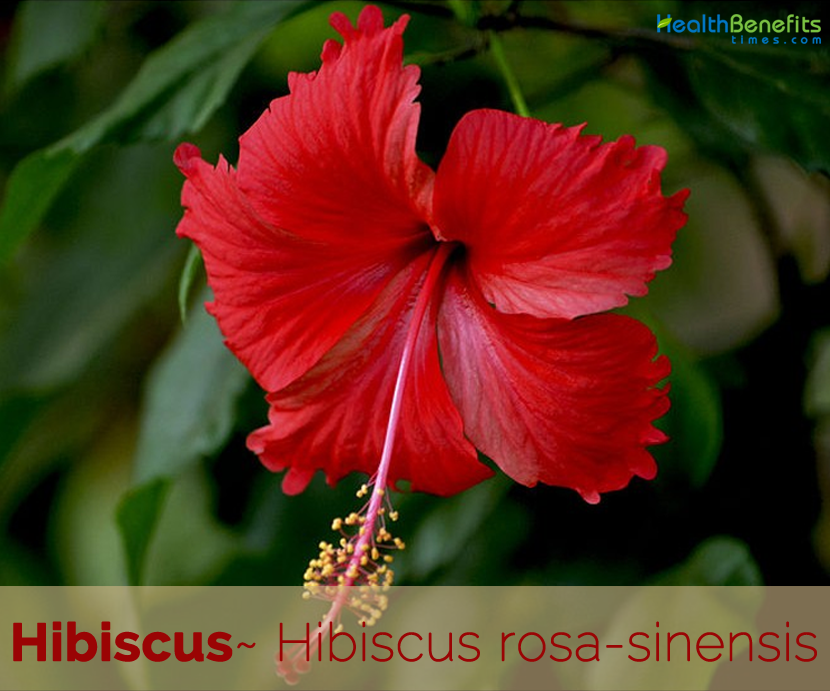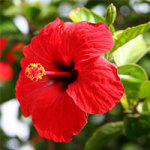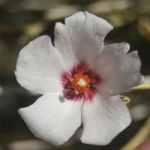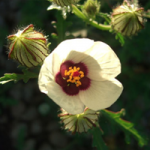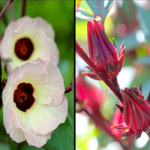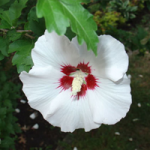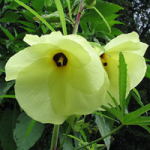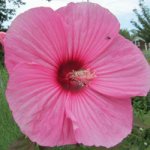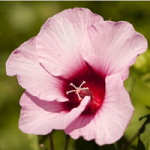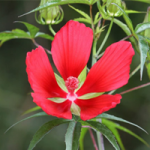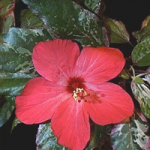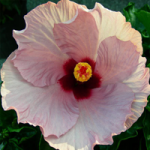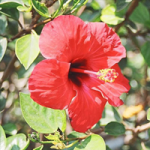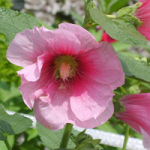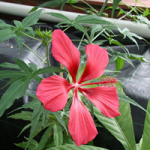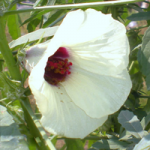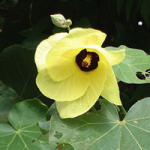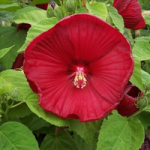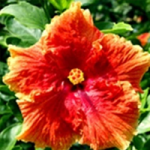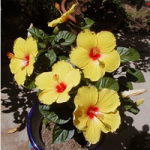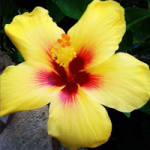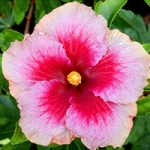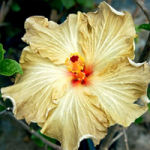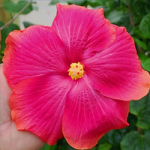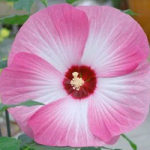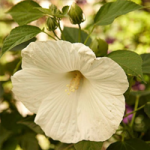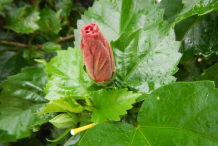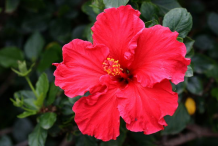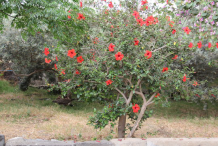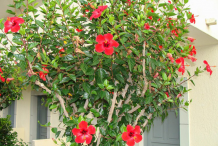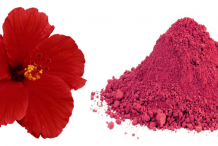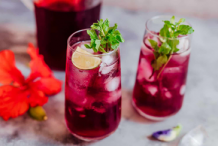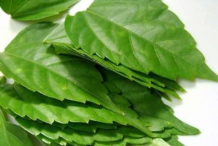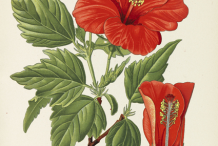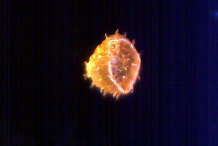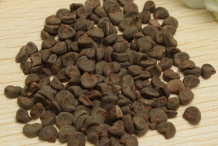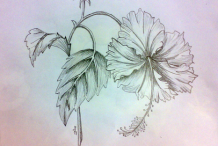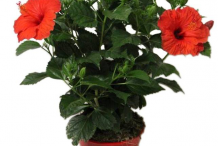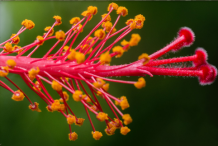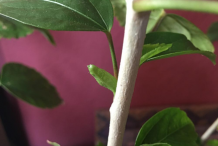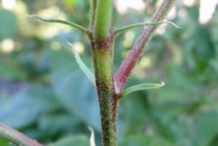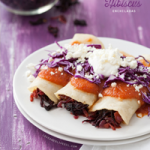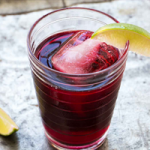The word bunga in Malay means “flower”, while raya in Malay means “celebratory” or “grand”. The Hibiscus rosa-sinensis is literally known as the “celebratory flower” in Malay. The red of the petals symbolizes the courage, life, and rapid growth of the Malaysian, and the five petals represent the five Rukun Negara of Malaysia. The flower can be found imprinted on the notes and coins of the Malaysian ringgit.
Plant Description
Hibiscus is an erect, much-branched, glabrous, evergreen shrub that grows about 2.5–5 m (8–16 ft.) tall and 1.5–3 m (5–10 ft.) wide. The plant normally prefers well- drained fertile soil high in organic matter. The plant has branched tap root and erect, green, cylindrical and branched stems. Leaves are alternate, papery, dark green, broadly or narrowly ovate, 4–9 × 2–5 cm, base rounded or cuneate, margin serrate-dentate, apex acuminate; stipules linear, 5–10 mm long; petiole 0.5–2 cm long. Plants grown outdoors year round typically rise to 10-12 inch tall, and plants grown in containers that are overwintered indoors are typically trimmed to 5-6 inch tall. Outdoor plants will flower throughout the year.
Flower & Fruit
Flowers are solitary, axillary on upper branches, large, simple or double, usually pendulous on 1–8 cm long pedicels. Epicalyx lobes are 6–9, linear or linear lanceolate. Calyx is campanulate with 5 ovate to lanceolate, stellate puberulent, lobes. Corolla is white, rosy red, reddish or orange-yellow or purplish, funnel-shaped, 6–10 cm in diameter, often double; petals are obovate, imbricate, pilose abaxially, apex obtuse or irregularly lobed. Staminal column are exserted, glabrous, antheriferous near the apex, style 5-fid each branch crowned by stigma. Flowers are followed by dehiscent, ovoid capsule, 2.5 cm, glabrous with beaked apex splitting. Fruit consists of small, black seeds.
Hibiscus flowers come in many colors. They can be red, yellow, white, or peach-colored with both single and double sets of petals. Plants with double sets of petals have been named as var. rubroplenus Sweet. Hibiscus rosa-sinensis was nominated as the national flower of Malaysia in 1960. The most popular variety is Hibiscus sabdariffa. Red flowers of this variety are most commonly cultivated for medical purposes, and are available as dietary supplements. Outdoor plants will flower throughout the year. Plants brought indoors in fall typically flower from spring to late summer. Flowers last for only one day. Indoor plants need regular pruning to maintain good shape.
History
Originating in southern China, the hibiscus travelled throughout the south pacific and into Hawaii. Its popularity as a blooming plant made it a welcomed immigrant in Europe in the 1700’s after the Chinese had bred various colors. The hibiscus was introduced to America in 1842 at a flower show in Philadelphia. Originally a popular catalog order, the flower made its way across the states and eventually Hibiscus groups and societies were formed furthering the variety of bloom colors and overall plant sizes. Today hibiscus is found growing throughout the world due to its appealing appearance and wonderful benefits.
Types of Hibiscus
Hibiscus is a flowering plant that is typically grown in warm tropical climates. These flowers are large and are shaped like a trumpet. There are around 200 species of this plant and they belong to the mallow family. Listed below are some of the popular varieties of Hibiscus
1. China rose
China rose is also known as blackening plant as its flowers are used in the tropics to polish shoes. It is a popular Asiatic shrub which attains the height of 15 to 25 feet while withstanding frost. It has oval shaped flowers which are 3 to 4 inches long. The blooms are mainly in the red shade but some yellow, pink and orange varieties are also available.
2. Rock Hibiscus
Rock hibiscus is native to Mexico and the United States. The shrub which bears this flower clings to the rocky formations and can even survive elevation of up to 2000 feet. The shrub bears sparse foliage of triangular gray leaves.
3. Flower of an Hour
Flower of an Hour is also known as Hibiscus trionum. It grows up to 4 feet in height and produces cream to yellow colored blossoms.
4. Roselle
This flower is commonly known as Indian Roselle. The plant has solitary yellow flowers and is stalk-less. It is an annual or perennial shrub growing up to 7 to 8 feet.
5. Rose in Sharon
Rose in Sharon is another name of Hibiscus syriacus. It is a hardy and an easy to grow shrub. It blooms from late summer to mid-autumn. It is abundantly available in South Korea and blooms in a variety of shades like white, purple and violet.
6. Abelmosk
This hibiscus is also known as Musk mallow, Kasturi and Musk seed in India. This is an annual plant which grows from 2 to 6 feet in height. This hibiscus is native to India and is well known for its musky perfume.
7. Giant Rose Mallow
Giant rose mallow strongly looks like Hibiscus Moscheutos, has broader leaves and is quite tall in height. Flowers are pink in color while some are in white with a dark red center.
8. Hibiscus Moscheutos
Hibiscus Moscheutos is a multicolored flower. It is a perennial shrub which grows up to 3 to 8 feet in length. Its color ranges from pure white to deep rose with a deep maroon center. It belongs to the family of Malvaceae, which is commonly known as rose mallow.
9. Rose Mallow
Rose Mallow is hibiscus moscheutos, often referred to as sea mallow swamp and swamp rose mallow. It is a deciduous hibiscus shrub that grows in cold regions. The flowers are around 4 to 7 inches wide long with green, oval leaves.
10. Checkered Hibiscus
It is crimson colored hibiscus belongs to the Malvaceae family. It has deep green leaves with shiny foliage and the flower blooms in pink, red, white and cream colors. The flower has a diameter of about 4 inches and looks strikingly beautiful.
11. Hawaiian Hibiscus
Hawaiian hibiscus is the seven known species of hibiscus reared as native to Hawaii. This hibiscus has large petals which are mainly bright in color.
12. Hibiscus Sabdariffa
It is mainly grown in gardens and is one of the most popular varieties of hibiscus. It is also known as Roselle hibiscus. The flower is white to pale yellow and has a red spot on each petal.
13. Hibiscus Mutabilis
This hibiscus variety is known as Confederate rose or Dixie rose mallow. The flowers are in double bloom and have white or green foliage. This flower blooms from summer to fall and is approximately 4 to 6 inches in diameter.
14. Hibiscus Coccineus
Hibiscus Coccineus is also known as Texas Star hibiscus. It grows up to 7 feet tall and produces red flowers, 3 to 4 inches in diameter.
15. Hibiscus Cannabinus
Hibiscus cannabinus is known as Kenaf and belongs to the Malvaceae family. This flower is well known for the fiber obtained from it. Its fiber is used in the manufacturing of jute.
16. Hibiscus Tiliaceus
It belongs to the Mallow family and its common names are Sea hibiscus and coast hibiscus. The flowers are bright yellow in color with red centers and have long, flexible stems.
17. Hibiscus Luna Red
It is a compact bushy plant with gigantic flowers. It has five petaled blooms with bright green foliage. The shorter variety of this flower is an excellent choice for garden and decorations. This flower grows well in well-drained, fertile soil with ample moisture.
18. Mango Liqueur
This hybrid hibiscus has wide blooms of 6 to 8 inches and has petals like old, ruffled flowers. This is an easy to grow plant and grows up to 7 meters in height.
19. Exuberance
It has large, multicolored blooms which are nearly 7 to 9 inches wide. The flower blooms in colors like yellow, orange, red and pink.
20. Beach Beauty
Beach beauty is a large 8 inches flower in rings of golden yellow, white and candy pink. The flower has a bright red eye with tints of orange around the edges.
21. Secret Heart
Secret heart is a lovely two-toned pink flower with a red center. It is a large flower which grows well in alkaline soil. This flower develops in pink and red shades in cooler weather and blooms in blue color in warmer weather conditions.
22. Champagne
Champagne hibiscus blooms with a large 8 inches single flower that has hints of yellow and a tiny red center. It is a hybrid between ‘Muffin Man’ and ‘Rainbow Christie’ and has smooth, even colored flowers.
23. Aphrodite
Aphrodite is valued for its large single, dark pink flowers with bright yellow centers. This flower blooms in mid to late summer in a sunny or partial shade. This deep fuchsia 6 to 8 inches wide flower sizzles against the dark green velvety foliage.
24. Luna Pink Swirl
It is a hardy perennial plant which produces large white and pink flowers with red centers. The flower is 8 inches in diameter and the plant grows 8 feet tall. The plant grows well in moist, fertile and well-drained soil.
25. Hibiscus – Blue River II
This plant can be easily grown in average to medium soil but grows best in organically rich soils and under the full sun. The plant grows to a height of 4 to 5 meters which bears 5 petaled hollyhock blooms.
Health benefits of Hibiscus
Hibiscus is used for making ayurvedic and herbal medicines. Ayurveda uses hibiscus parts like leaves, flowers and roots to cure headaches, swelling, menstrual cramps, hair care, colds, venereal disease, encourage short term infertility and stimulate menstruation. It is also used as a laxative. People use the hibiscus flowers to make chutneys, soups and curries. Let’s take a look at the ways in which hibiscus can improve your health.
1. Lowers Cholesterol
According to research, hibiscus can lower cholesterol levels. Artery clogging cholesterol can up your risk of heart disease but animal studies have shown that hibiscus flower extracts taken orally might be able to lower total cholesterol levels by as much as twenty two percent. Moreover, it also increases levels of HDL cholesterol. It is thought that saponins present in hibiscus bind to cholesterol and prevent its absorption in the body.
2. Aids Weight Loss
Hibiscus is quite beneficial for weight loss. Being loaded with nutrients, flavonoids and various minerals, hibiscus lowers the body’s absorption of fats and carbohydrates. This in turn can help you lose weight.
Apart from that it also contains high concentrations of antioxidants that aid weight loss by boosting metabolism. Also, being diuretic in nature, this herb helps shed water weight.
3. Help Treat Depression
Some of the key polyphenols found within the hibiscus plant have been shown to display a protective effect on the brain, while also increasing blood flow. As a result its supplementation has been shown to improve mood and reduce depressive symptoms.
While this research is still in its early stages, it does suggest that hibiscus flower may offer a natural additional to some of our more traditional depression treatments, while also acting as a potent mood enhancer.
4. Cures Fever, Constipation, and Cold Cures
Since ancient times, hibiscus has been used in different cultures as a remedy for treating various conditions. Egyptians used the hibiscus tea for lowering the temperature of the body, treating nerve and heart diseases, and the best use was as a diuretic. Due to the cooling effects of hibiscus tea, fever can also be reduced. In other parts of the world such as Africa, the parts of the plant were used in the treatment of liver disease, symptoms of cold and constipation. Hibiscus flowers have been popularized as a healthy flower and also used as a medicine in menopause treatment. The pulp or juice made from these leaves can treat skin wounds. This is one of the most know hibiscus tea benefits around the world.
5. Improves Hair Growth
Crushed leaves of hibiscus have been used as a soapy paste to clean hair. It is supposed to strengthen hair and promote healthy hair growth. Now, scientific studies have also found that hibiscus leaf extracts can promote hair growth. So if you’re looking for thick beautiful tresses try shampooing with hibiscus leaves.
6. Lowers Blood Sugar
Hibiscus tea is a wonderful option if you’re worried about your blood sugar levels. High blood sugar can affect the functioning of your nerves, eyes, and kidneys and increase your chances of getting heart disease too. But research has discovered that taking a hibiscus flower extract orally for twenty one days reduced blood glucose levels by forty one to forty six percent.
7. Boosts Immune System
Immune system is actually the body’s defense against all sorts of diseases. According to research, extracts of hibiscus flowers may be able to encourage cells which fight infection. So to strengthen the natural defenses of your body try a cup of hibiscus tea.
8. Beneficial For Hair
Hibiscus plant consists of good amount of Vitamin C and minerals. Polyphenol compounds in the leaves of this plant have been known to contain anti-inflammatory properties. Flowers are supposed to cure ailments such as loss of hair, cough, and graying of hair. For natural hair treatment with hibiscus, the flowers are dried, ground to fine powder, and mixed with some water to apply on the scalp.
9. Fights Hair Loss
If you are worried about hair loss, hibiscus can help fight it. Being rich in vitamins A and C as well as amino acids, hibiscus helps to combat hair loss and induce hair growth. It also cures dandruff, prevents split ends and prevents premature graying.
10. Boosts liver health
Research has shown that hibiscus may promote liver health and help keep it working efficiently. Further research is however required to know how hibiscus tea affects liver health in humans.
11. Heals Wounds
A cup of hibiscus tea just might be able to help heal any wounds or nicks that you have. Hibiscus flower extract, when taken orally, was found to quicken wound healing, and lead to faster skin growth in rats when compared to controls who were not given the hibiscus extract.
12. Can Protect Against Skin Cancer
Exposure to the harmful UV rays of the sun and certain harmful chemicals are known to promote skin cancer. But hibiscus might have a protective effect. According to a research, the topical application of hibiscus extract before exposure to UV rays and the toxic chemical benzoyl peroxide was able to partly restore levels of protective enzymes which prevent cellular damage.
13. Can Treat Head Lice
Hibiscus flower helps to remove head lice. You would be surprised to know that hair loss that occurs due to thyroid problems can also be prevented to some extent if you consume a cup of healthy hibiscus tea or apply a smooth hibiscus paste on the scalp. To prevent premature graying of hair, parts of hibiscus plant can stimulate the production of the blood and ensure that vital nutrients reach the hair follicles.
Traditional uses and benefits of Hibiscus
- Various parts of H. rosa-sinensis are used for various ailments in traditional medicine.
- rosa- sinensis has been reported to possess anti-estrogenic, anti-implantation, abortifacient, antipyretic, antispasmodic, CNS depressant, hypotensive, anti-spermatogenic, embryo toxic, hypothermic, insect attractant, analgesic, antifungal and anti-inflammatory properties.
- Flower buds, pounded into a paste, are applied as a poultice to boils, cancerous swellings and mumps in Philippines.
- Chinese women used to use the juice from the petals for blackening their eyebrows, and so did people in India.
- Decoction of flowers has been used as an expectorant in bronchitis.
- Flower infusion after a night’s exposure to dew may be used for gonorrhea.
- Chinese and Annamese use the flowers against paralysis and dysmenorrhea.
- Decoction of the flowers has been reported effective for coughs.
- Red flowers are supposed to regulate menstruation and sometimes said to cause abortion and also used for sprue in Indonesia.
- Flowers, fried in ghee, are given in menorrhagia in India.
- Dark-red petals are used in the form of a mucilaginous infusion in ardor-urinae, strangury, cystitis and other irritable conditions of the genito-urinary tract.
- Infusion is also a refrigerant drink in fevers and a demulcent in coughs.
- Oil made by mixing the juice of the fresh petals and olive oil in equal proportions and boiling is useful as a stimulating application for increasing the growth and improving the color of the hair.
- Leaves and flower buds are mashed and applied on swellings externally, and that the same mixture with lime hastens maturation of tumors in Philippines.
- Flowers, leaves, barks and roots in decoction are used as an emollient.
- Seeds, pounded into a pulp and mixed with water, were used effectively for gonorrhea in India.
- Decoction of the leaves has been used as a lotion for fevers and an infusion or a poultice of the leaves for headache in Malaysia.
- Leaves have also been used for boils.
- In Indonesia, it was very common to poultice swellings with the leaves.
- Midwives applied the mucilage during labor, at the same time giving draughts of the juice of the leaves.
- Juice of the leaves among with that of Vernonia cinerea is used by midwives to stimulate the expulsion of the afterbirth.
- Leaves are used as an emollient, an anodyne and a gentle aperient in China.
- Preparation from the leaves is used to treat postpartum relapse sickness, to treat boils, sores and inflammations in Samoa.
- Malays used a decoction of the root as an internal medicine in Malaysia.
- Decoction from the roots of red- and white-flowered plants is a Kelantan antidote for poisons.
- Decoction is also drunk for venereal diseases and fevers.
- An infusion of the root is also used for glands in the neck.
- An application of the root of the white- flowered plant was also used for carbuncles, a decoction being drunk at the same time.
- Decoction of the root may be dropped into sore eyes.
- Root is regarded valuable for coughs in India.
- Chinese and Annamese use the bark as an emenagogue.
- Leaves are used to treat abscesses and to induce vomiting in NW Guyana.
- Flower boiled and the extract used to treat delayed menses and as an abortifacient in Guyana.
- Paste made from the root is used in the treatment of venereal diseases.
- Paste prepared from hibiscus flower and cow’s urine when applied over head is beneficial for hair loss and treats baldness.
- Paste prepared from hibiscus leaves when applied on head gives important nourishment for the hair.
- Equal amount of hibiscus flower juice and sesame oil is heated until only oil is remained. The remaining oil is beneficial for treating dandruff.
- 10-30 ml Root decoction when taken with honey is beneficial for cough.
- 15 ml root decoction when taken 3-4 times a day is beneficial for cough and common cold.
- 5-10 ml leaf juice is beneficial for diarrhea and other digestive problems.
- Regular use of flower powder in a cup of milk is beneficial for overcoming blood deficiency and provides energy to your body.
- Powder prepared from dried flower and leaves when taken with a cup of milk is beneficial for increasing the memory power.
- Paste prepared from leaves and flowers when applied over affected area is beneficial for swelling and pain.
Ayurvedic Health benefits of Hibiscus
- Leucorrhoea: Add 2 tsp leaf juice of Shoe Flower in a cup of water. Drink it twice a day. OR : Drink 10 ml leaf decoction of Shoe Flower twice a day.
- Urinary Problems: Use flowers of Shoe Flower plant to make decoction. Drink 30 ml once a day.
- Coolant: Prepare a flower decoction of Shoe Flower plant. Drink 2 tsp once a day.
- Hyperthermia: Take 200 g flower petals of Shoe Flower plant. Add 1 liter water and 400 g Jaggery in it. Boil until it gets half and thick. Take 5 g of it once a day.
- Baldness: Take flower petals of Shoe Flower. Crush them to extract juice. Boil the juice with coconut oil. Store and use for head massage.
- Hair: Crush leaves of Shoe Flower plant to extract its juice. Apply it over your hair and scalp. Wash after sometime.
- Menstrual Problems: Fry 2 flowers of Shoe Flower plant in butter. Take it with warm milk once a day.
- Mumps: Grind the leaves and flowers together and make a paste. Apply it as a poultice onto the mumps.
- Fever: Prepare a leaf decoction of Shoe flower and apply as a lotion on your body to normalize temperature.
- Alopecia Areata: Take 8 to 10 flowers of Shoe Flower plant. Boil them in half a liter of coconut oil. Strain the oil. Store it in a bottle. Now apply this oil 3 times in a week and leave it over night. Repeat the process on regular intervals to get good results.
- Jaundice: Boil one tbsp each of trailing Eclipta leaves, Azadirachta indica flowers, radish and shoe flower in half liter water till water is reduced to half. Take thrice a day with one tbsp sugar.
- Cough: Take 20 g root of Shoe Flower and 50 g leaves of Adhatoda Vasica. Make its decoction. Drink 30 ml twice a day.
- Leucorrhoea: Prepare a decoction with flowers of Shoe Flower. Take 30 ml of it and add 20 ml milk, 1 tsp Jaggery and half tsp carom. Drink 20 ml once a day.
- Hair Fall: Add 10-12 Shoe Flower into 1 to 2 cups of coconut oil. Heat them together until burnt. Strain this to separate oil from solution. Before sleep apply this oil to your scalp. Wash off your hairs in the next morning. Repeat this for one to two times a week.
Culinary Uses
- Flower petals and young leaves are edible.
- Slightly acidic petals are used sparingly in salads or as garnish.
- Flowers are eaten as pickles and the young leaves are eaten cooked in Papua New Guinea.
- Flowers are eaten in salad in the Pacific Islands.
- Flowers are pounded into a paste and used as chutney in Andhra Pradesh, India.
- Flowers are also used in herbal teas and as food coloring.
- Young leaves are gathered for relish in some areas in Africa.
- Hibiscus flowers have a tart, cranberry-like flavor and should be used sparingly.
- Lecture Room and Library at Sketch has created a wonderful dish of rhubarb, brie and gingerbread with hibiscus syrup and celery for the 2013 Chelsea Flower Show.
- Young leaves are sometimes used as a spinach.
Other Facts
- It is a very popular and widely planted ornamental, planted as hedges and for fence or in median strips of avenues, as garden plants and in parks.
- Outside the tropics and subtropics, it is also a popular indoor plant.
- Plant is sometimes used as a fiber source in India and China.
- Black pigment is extracted from the flowers.
- Hibiscus flower and leaf preparations are used for hair care.
- Petals are used to blacken shoes and eyebrows in parts of India, as well as for the worship of the Hindu deity, Devi.
- Bees, butterflies and hummingbirds are main pollinators of hibiscus flowers.
- Hibiscus is known as “shoe flower” in China because people use hibiscus to polish their shoes.
- People in Polynesia use fibers from the bark of hibiscus tree to produce grass skirts.
- Women in Tahiti and Hawaii wear hibiscus flower behind the right ear when they want to announce that they are single and ready for marriage. Married women wear hibiscus behind the left ear.
- Women in China use dyes extracted from hibiscus flowers to dye their eyebrows and hair.
- Paste made of crushed hibiscus leaves and flowers can be used as home-made shampoo.
- Hibiscus cannabinus is a species of hibiscus that is used in the paper industry.
- China and Thailand are the greatest producers of hibiscus in the world.
- Hibiscus is the recognized national flower of Malaysia, South Korea and the Republic of Haiti.
Precautions
- Do not use during pregnancy or if planning children.
- It may cause infection in eyes.
- It should not be taken by the women who are in medication for fertility treatments. The levels of estrogen in the body are reduced; menstruation is triggered and a miscarriage might be the result.
- Hibiscus tea and hibiscus supplements are not recommended for women who are taking birth control pills.
- Do not take hibiscus if you are suffering from low blood pressure. It might lower the levels more.
- People with diabetes should take caution when taking this herb as it can decrease blood sugar levels.
Hibiscus Flower Enchiladas
Ingredients:
For Filling:
- 1 cup dried hibiscus flowers
- 1/4 cup olive oil
- 1 large onion, thinly sliced
- 2 large carrots, grated
- 1/2 cup grated jicama
- 1/4 cup sugar
- 1/2 teaspoon ground dried oregano
- 1/4 teaspoon dried thyme leaves
- Kosher salt and freshly ground black pepper
For Sauce:
- 2 pounds ripe plum tomatoes, cored, halved (or substitute 1 28-ounce can of whole plum tomatoes, drained and halved)
- 1/2 white onion, chopped
- 3 garlic cloves, thinly sliced
- 2 canned chipotle chiles in adobo
- 2 tablespoons vegetable oil
- 3 large dried bay leaves
- Kosher salt
For Assembly:
- Vegetable oil, for frying
- 12 6-inch corn tortillas
- 1 cup sour cream
- 1 cup thinly sliced purple cabbage (from about 1/2 a small cabbage)
- 1/2 cup Cotija or feta cheese, crumbled
Directions:
- For filling, bring hibiscus flowers and 2 cups water to a simmer in a small saucepan. Remove from heat; let steep until flowers are just tender, 5–8 minutes. Strain, reserving flowers (the liquid can be saved for another use).
- Heat olive oil in a large heavy pot over medium heat; add onion and sauté until softened, 3 to 5 minutes.
- Add softened hibiscus flowers, carrots, jicama, sugar, oregano, and thyme and cook, stirring occasionally, until carrots are tender and liquid is mostly evaporated, about 15 minutes.
- Season with salt and pepper. Keep warm.
- Meanwhile, combine tomatoes, onion, garlic, and chipotle chilies along with 2 cups of water in a large saucepan over medium heat.
- Cook, stirring occasionally, until tomatoes begin to break down, about 20 minutes.
- Remove from heat and transfer mixture to a blender; in batches if necessary (be cautious blending hot liquids). Purée until smooth.
- Carefully wipe out saucepan; add oil and return to medium-high heat.
- When oil begins to shimmer, carefully add tomato mixture and bay leaves.
- Bring to a boil; reduce to a simmer, and cook, stirring occasionally, until thickened, about 10 minutes.
- Season to taste with salt.
- Pour vegetable oil into a large skillet to a depth of 1/4-inch; heat over medium-high heat until shimmering.
- Working in batches, submerge tortillas and fry, turning once, until just softened, about 30 to 45 seconds (no longer, you do not want them crispy).
- Transfer to a paper-towel-lined plate to drain. Spoon 1/4 cup of filling down the center of each tortilla and roll to enclose.
- Spoon chipotle sauce over top and garnish with sour cream, cabbage, and cheese.
Hibiscus Tea
Ingredients
- 2 quarts water
- 3/4 to 1 cup sugar (depending on how sweet you would like it to be)
- 1 cup dried hibiscus flowers
- 1/2 cinnamon stick (optional)
- A few thin slices ginger (optional)
- Allspice berries (optional)
- Lime juice (optional)
- Orange or lime slices for garnish
Directions
- Put 4 cups of the water and the sugar in a medium saucepan.
- Add cinnamon, ginger slices, and/or a few allspice berries if you would like.
- Heat until boiling and the sugar has dissolved. Remove from heat. Stir in the dried hibiscus flowers.
- Cover and let sit for 20 minutes. Strain into a pitcher and discard the used hibiscus flowers, ginger, cinnamon, and/or allspice berries.
- Add remaining 4 cups of water (or if you want to chill the drink quickly, ice and water) to the concentrate, and chill.
- Alternatively you can add ice and chilled soda water for a bubbly version. Add a little lime juice for a more punch-like flavor.
References:
https://www.itis.gov/servlet/SingleRpt/SingleRpt?search_topic=TSN&search_value=21616#null
https://davesgarden.com/guides/pf/go/47435/
https://npgsweb.ars-grin.gov/gringlobal/taxonomydetail.aspx?id=19075
https://pfaf.org/user/Plant.aspx?LatinName=Hibiscus+rosa-sinensis
http://www.missouribotanicalgarden.org/PlantFinder/PlantFinderDetails.aspx?kempercode=b557
https://www.healthline.com/health/all-you-need-to-know-hibiscus
https://plants.usda.gov/core/profile?symbol=HIRO3
http://www.theplantlist.org/tpl1.1/record/kew-2850448
https://en.wikipedia.org/wiki/Hibiscus
Comments
| Hibiscus Quick Facts | |
|---|---|
| Name: | Hibiscus |
| Scientific Name: | Hibiscus rosa-sinensis |
| Origin | East Asia China |
| Shapes | Dehiscent, ovoid capsule, 2.5 cm |
| Taste | Tangy citrusy taste (Flower) |
| Major nutrients | Manganese (49.13%) Iron (2.38%) Calcium (1.90%) Magnesium (1.67%) Potassium (1.00%) |
| Health benefits | Lowers Cholesterol, Lowers Blood Sugar, Can Treat Head Lice, Improves Hair Growth, Can Protect Against Skin Cancer, Fights Hair Loss, Aids Weight Loss, Heals Wounds, Boosts liver health, Boosts Immune System, Help Treat Depression, Cures Fever, Beneficial For Hair, Constipation, and Cold Cures, |
| Name | Hibiscus |
|---|---|
| Scientific Name | Hibiscus rosa-sinensis |
| Native | East Asia China. It is now widely distributed and cultivated in the tropics and subtropics |
| Common Names | China Rose, Chinese Hibiscus, Hawaiian Hibiscus, Hibiscus, Hibiscus Flower, Jamaica Flower, Rose Mallow, Rose of China, Shoeblack Plant Hibiscus, Shoe flower |
| Name in Other Languages | Afrikaans: Gewone hibiscus, hibiscus Albanian: Hibiscus Andhra Pradesh : Dusanna Assamese: Jaba Arabic : Angharae-Hindi, Angharaehindi, Angharae-Hindi, كركديه(karakdih) Armenian: Hibiscus Azerbaijani: Amber çiçeği Basque: Hibiscus Belarusian: Hibiskus (Гібіскус) Bengali: Jiwa, Joba, Oru, Gōlāpa phula (গোলাপ ফুল) Bosnian: Hibiskus Brazil : Hibisco, Mimo-Chinês, Rosa Da China, Mimo De Vênus Bulgarian: Khibiskus (хибискус) Burmese : Khaung-yan Catalan: Hibisc Cebuano: Hibiscus Chichewa: Hibiscus Chinese : Zhu Jin (朱槿), Da Hong Hua (大红花), Tai Hua Fa, Chijin, Riji, Fusang (佛桑), Fosang, Hongfusang, Hongmujin, Sangjin, Huohonghua, Zhaodianhong, Songjin (桑槿), Erhonghua, Huashanghua, Tuhonghua, Jiamudan, Zhongguoqiangwei, Yuè yuè kāi (月月开), Zhūjǐn mǔdān (朱槿牡丹), Zhuàngyuán hóng (状元红), Suān cù huā(酸醋花) Colombia : Pejo Cook Islands : Hibiscus, Kaute, Kaute ‘ Enua, Kaute Kula, Kaute Kumu, Kaute Kura Croatian: Hibiskus Czech : Ibišek čínská růže, ibišek Danish : Hawaiiblomst, Kinesisk Rose, hibiscus Dutch : Chinese Roos, hibiscus English: China rose, Chinese hibiscus, Hawaiian hibiscus, Hibiscus, Rose-of-China, Shoeblackplant, Chinese roos, Common Red, Double rose-hibiscus, Hibiscus ‘Lipstick’, Shoe flower, Shoe-back Plant, Tropical Hibiscus Esperanto: Hibiscus Estonian : Rooshibisk, hibisk Farsi: Angaraehindi Fiji : Kauti, Loloru, Senitoa Yaloyalo, Senicikobia Filipino: Hibiscus Finnish: Kiinanruusu, hibiscus French : Hibiscus De Chine, Hibiscus Rose D Chine, Rose De Chine, Chinesischer Roseneibisch, hibiscus Galician: Hibisco Georgian: Hibiscus German : Chinesischer Roseneibisch, Roseneibisch, China-Hibiskus, Hibiskus Greek: Yvískos (υβίσκος) Gujarati: Jasunt, Jasvua, Hibiskasa (હિબિસ્કસ) , jasud, jasuva, Haitian Creole: Hibiscus Hausa: Hibiscus Hebrew: הִיבִּיסקוּס Hindi: Gudhal, Gurhal, Guthur, Jassoon, Jasum, Jasun, Jasund, jasut, Gurhal, Jasut, Java, Odhul, hibiskus (हिबिस्कुस) Hmong: Hibiscus Hungarian: Hibiszkusz Icelandic: Hibiscus Igbo: Hibiscus Indonesia : Woro-Wari, Kembang Wera, Kembang Sepatu Irish: Hibiscus Italian : Rosa Della Cina, ibisco Japanese : Fusou, Haibisukasu (ハイビスカス) Javanese: Waru Kannada: Dasavala (ದಾಸವಾಳ),dasnigae Kazakh: гибискус Khmer: Hibiscus Korean: Hibiseukeoseu (히비스커스) Laotian : Dok Deng, May, hibiscus Latin: Texit hibisco, Pieride Latvian: Hibiskusroze Lithuanian: Hibiscus Macedonian: хибискус Malaysia : Baru Landak, Botan, Bunga Waktu Besar, Bunga Raya, Mati Bini, Mati Laki, Laki Pukul Bini Malagasy: Hibiscus Malayalam: Dasavala, Aimparutti, Ain-Pariti, Ayamparutti, Cemparatti (ചെമ്പരത്തി), Cemparutti, Champarutti, Chebarathi, Chemburuthi, Chemparutti, Himbarathi, Jampa, Japa, Schem-Pariti, Shemparatti, Schempariti, Maltese: Hibiscus Manipuri: Jubakushum ( Manipuri), Maori: Puarangi Marathi: Darshan, Dasindachaphula, Jaasavand, Jasavanda, Jasund, Jassvandi, Jasvand, Uṣṇa pradēśāta vāḍhaṇārē mōṭhyā camakadāra phulān̄cē rōpaṭē (उष्ण प्रदेशात वाढणारे मोठ्या चमकदार फुलांचे रोपटे) Mizoram: China Pangpar, Chinnpang-Par, Midumpangpar Marquesas Islands : Koute Mexico : Bis, Gallarde, Lamparilla, Sùchel, Tulipán Mongolian: Hibiscus Myanmar (Burmese): Hibiscus Nepalese : Baarhmaase Phuul, Gudahal, Japaa Kusum, Japa Puspii, Rakta Puspi, Jābhā phula (जाभा फुल) Niue : Kaute Norwegian: Hibiscus Oriya: China Pangpar, Mandar, Midumpangpar, Mondaro,ophulo Panama : Clavel Japonés, Hibiscus De Los Jardines, Papo, Palo De La Reina, Tapo Papua New Guinea : Banban, Gelegwaugwau, Ovaova Vava’a, Hibiscus Persian : Angarae-Hindi, Angaraehindi, Angharae-Hindi Philippines : Kayanga, Antalongan, Gumamela, Kayanga, Tapuranga, Tarokanga, Saysayam, Kayanga, Aratangan, Gumamela, Tapolanga, Tarokanga, Taukangga, Antalongan, Gomamela, Gumamela, Tapolanga Polish : Hibiskus róza chinska, Ketmia Róza-Chinska, poślubnik Portuguese : Rosa-Da-China, Hibisco, Mimo-chinês, Mimo de Vênus, Hibisco Punjabi: Jaipushpa, Jasum, Gurhal Rarotonga : Kaute Romanian: Hibiscus Russian: Gibiskus (гибискус) Samoa : Aute Sanskrit: Arkapriya, Aruna, Aundrapuspa, Harivallabha, Japa, Japaapushpa, Japapushpa, Japapushpam, Java, Joba, Odhrapushpa, Odrapuspa, Ondrakhya, Ondrapuspi, Oundrapuspa, Pratika, Raktapushpi, Rogapuspi, Rudhrapushpa, Trisandhya Serbian: Hibiskus (хибискус) Sesotho: Hibiscus Sinhala: Hibiscus Slovak: Ibištek Slovenian: Hibiscus Somali: Hibiscus Spanish : Clavel japonés, Hibiscus de los jardines, Papo, Palo de la reina, Pejo, Rosa de China, Tapo, hibisco Sri Lanka : Wada Mal Swahili: Hibiscus Swedish : Hibiskus, Kinaros Tajik: Hibiscus Tahiti : ‘Aute Taiwan : Fo Sang, Fu Sang Tamil: Sapattuu, Semparathai, Semparuthi, Semparutti, Shamberattai, Tacanapu, Tacanpu, Tamalomaya, Tarupaka, Tiruttikkiritam, Uruttiraputpam, Cemparutti (செம்பருத்தி) Telugu: Cembarattamu, Chimabarathamu, Daanachettu, Dasana, Dasanipu, Daasaana Chettu, Daasaani, Daasanamu, Dasana, Dasanamu, Dasani, Dasanie, Japa, Japapushpamu, Javapushpamu, Mandara (మందార), Madarapuvvu, Nandara, Thai : Chaba (ชบา) Turkish: Ebegümeci Tuvalu : ‘Aute Ukrainian: Hibiskus (гібіскус) Urdu: Gul-E-Gurhal, Gul Gurhal Taza, hibiscus Uzbek: Hibiscus Vietnam : Bụp, Râm Bụp, Dâm But, Hibiscus Welsh: Hibiscus Yiddish: Hibiskus (היביסקוס) Yoruba: Hibiscus Zulu: Hibiscus |
| Plant Growth Habit | Erect, much-branched, glabrous, evergreen shrub |
| Soil | Well- drained fertile soil high in organic matter |
| Plant Size | 2.5–5 m (8–16 ft) tall and 1.5–3 m (5–10 ft) wide |
| Root | Branched tap root |
| Stem | Erect, green, cylindrical and branched |
| Leaf | Alternate, papery, dark green, broadly or narrowly ovate, 4–9 × 2–5 cm, base rounded or cuneate, margin serrate-dentate |
| Flower | Solitary, axillary on upper branches, large, simple or double, usually pendulous on 1–8 cm long pedicels |
| Fruit Shape & Size | Dehiscent, ovoid capsule, 2.5 cm, glabrous with beaked apex splitting |
| Seed | Small, black |
| Taste | Flower: tangy citrusy taste |
| Plant Parts Used | Roots, leaves, flowers |
| Varieties |
|
| Major Nutritions | Manganese, Mn 1.13 mg (49.13%) Iron, Fe 0.19 mg (2.38%) Calcium, Ca 19 mg (1.90%) Magnesium, Mg 7 mg (1.67%) Potassium, K 47 mg (1.00%) Zinc, Zn 0.09 mg (0.82%) Sodium, Na 9 mg (0.60%) Vitamin B3 (Niacin) 0.095 mg (0.59%) Vitamin B9 (Folate) 2 µg (0.50%) Phosphorus, P 2 mg (0.29%) Choline 0.9 mg (0.16%) |
| Health Benefits |
|


